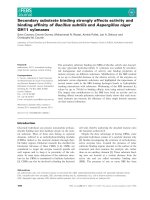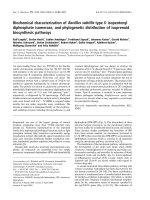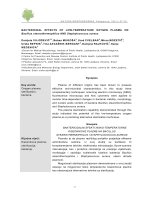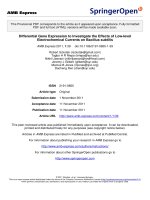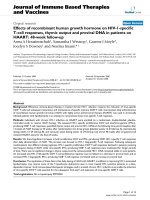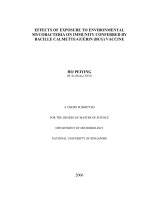Effects of cell free filtrate of bacillus subtilis h14 strain on sclerotium rolfsii causing white mold root rot disease in the peanut (khóa luận tốt nghiệp)
Bạn đang xem bản rút gọn của tài liệu. Xem và tải ngay bản đầy đủ của tài liệu tại đây (2.37 MB, 71 trang )
VIETNAM NATIONAL UNIVERSITY OF AGRICULTURE
FACULTY OF BIOTECHNOLOGY
-------------***--------------
GRADUATION THESIS
TITLE:
“EFFECTS OF CELL-FREE FILTRATE OF BACILLUS
SUBTILIS H14 STRAIN ON SCLEROTIUM ROLFSII
CAUSING WHITE MOLD ROOT ROT DISEASE
IN THE PEANUT”
Hanoi-2022
VIETNAM NATIONAL UNIVERSITY OF AGRICULTURE
FACULTY OF BIOTECHNOLOGY
--------------***--------------
GRADUATION THESIS
TITLE:
“EFFECTS OF CELL-FREE FILTRATE OF BACILLUS
SUBTILIS H14 STRAIN ON SCLEROTIUM ROLFSII
CAUSING WHITE MOLD ROOT ROT DISEASE
IN THE PEANUT”
Student’s name
: NGUYEN THI KHANH LINH
Class
: K63CNSHE
Student’s code
: 637332
Supervisor
: Dr. NGO THU HUONG
MSc. TRAN THI HONG HANH
Major
: MICROBIAL TECHNOLOGY
Hanoi-2022
COMMITMENT
I hereby declare that this is a scientific research work carried out by me
during the period from August 2022 to December 2022 under the guidance of Dr.
Ngo Thu Huong and MSc. Tran Thi Hong Hanh, Laboratory of Microbiology Faculty of Biotechnology - Vietnam National University of Agriculture.
The data and research results in this thesis are honest and have never been
published by anyone in other studies. The documents cited in the thesis are listed
in the references section.
Hanoi, 5th December, 2022.
Sincerely,
Nguyen Thi Khanh Linh
i
ACKNOWLEDGEMENT
First of all, I would like to thank the Academy's Board of Directors, lecturers,
and staff who are teaching and working at the Academy. I am extremely grateful
to the teachers of the Faculty of Biotechnology for teaching, guiding, and creating
conditions for me to complete my study program, professional internship, and
graduation thesis.
More specifically, I would like to express my deep respect and gratitude to
Dr. Ngo Thu Huong and MSc. Tran Thi Hong Hanh for guiding my research and
guiding me wholeheartedly during the course of this thesis. I would like to thank
the professors of Microbiology Technology, Assoc. Prof. Dr. Nguyen Xuan Canh,
Prof. Dr. Nguyen Van Giang, Ms. Tran Thi Dao, and fellow researchers: Ms.
Nguyen Thi Thu, Mr. Duong Van Hoan helped me during the thesis work.
Finally, I would like to thank my friends and my family for their
encouragement and help so that I could complete my graduation thesis.
Thank you from the bottom of my heart for everything!
Hanoi, 5th Decembr , 2022.
Sincerely,
Nguyen Thi Khanh Linh
ii
CONTENTS
COMMITMENT .............................................................................................................. i
ACKNOWLEDGEMENT ...............................................................................................ii
CONTENTS .................................................................................................................. iii
LIST OF TABLES ......................................................................................................... vi
LIST OF FIGURES .......................................................................................................vii
LIST OF ABBREVIATIONS ..................................................................................... viii
ABSTRACT ................................................................................................................... ix
PART 1. INTRODUCTION ......................................................................................... 1
PART 2. LITERATURE REVIEW ............................................................................. 4
2.1. Overview of peanuts ................................................................................................. 4
2.1.1. The history of peanuts ........................................................................................... 4
2.1.2. The situation of peanut production in the world and Vietnam .............................. 5
2.1.2.1. The situation of peanut production in the world ................................................ 5
2.1.2.2. The situation of peanut production in Vietnam .................................................. 6
2.1.3. The role of peanuts ................................................................................................ 8
2.1.3.1. The role of peanuts in the economy ................................................................... 8
2.1.3.2. The role of peanuts in agriculture ....................................................................... 9
2.1.3.3. The role of peanuts in human life ..................................................................... 10
2.1.4. White mold root rot disease on the peanuts by Sclerotium rolfsii ...................... 11
2.2. Overview of Sclerotium rolfsii ............................................................................... 12
2.3. Overview of bacteria .............................................................................................. 16
2.3.1. Overview of Bacillus subtilis .............................................................................. 17
2.3.2. Overview of Bacillus subtilis H14 ...................................................................... 22
2.3.3. The research situation in the world and Vietnam ................................................ 23
2.3.3.1. The research situation in the world .................................................................. 23
2.3.3.2. The research situation in Vietnam .................................................................... 25
PART 3. MATERIALS AND METHODS ................................................................ 26
3.1. Materials ................................................................................................................. 26
iii
3.1.1. Research location and time .................................................................................. 26
3.1.2. Research subjects................................................................................................. 26
3.1.3. Equipments .......................................................................................................... 26
3.1.4. Medium................................................................................................................ 26
3.2. Methods .................................................................................................................. 27
3.2.1. The dual culture method for testing antagonistic activity ................................... 28
3.2.2. Methods for testing the effects of cell-free filtrate from B. subtilis H14 strain on
the mycelial growth and sclerotial germination of Sclerotium rolfsii ........................... 29
3.2.2.1. Method of filtration through sterile filter paper ............................................... 29
3.2.2.2. Method of filtration through sterile Cellulose filter membrane with pore size
0.45 µm .......................................................................................................................... 29
3.2.2.3. Method of filtration through sterile Syringe filter membrane with pore size
0.22 μm.......................................................................................................................... 30
3.2.2.4. Mycelial growth inhibition test ........................................................................ 30
3.2.2.5. Hyphal morphology inhibition test ................................................................... 31
3.2.2.6. Sclerotial formation inhibition test ................................................................... 31
3.2.2.7. Sclerotial germination inhibition test ............................................................... 31
3.2.3. Sclerotial morphology inhibition test .................................................................. 33
3.2.4. Biocontrol of S. rolfsii on peanuts in vivo condition .......................................... 33
PART 4. RESULTS AND DISCUSSION .................................................................. 34
4.1. Antagonistic activity of B. subtilis H14 strain on S. rolfsii .................................... 34
4.2. Antifungal ability of cell-free filtrate from B. subtilis H14 strain on the mycelial
growth and sclerotial germination of Sclerotium rolfsii ................................................ 34
4.2.1. Antifungal ability of cell-free filtrate by using sterile filter paper ...................... 35
4.2.2. Antifungal ability of cell-free filtrate by using sterile Cellulose filter membrane
with pore size 0.45µm ................................................................................................... 36
4.2.3. Antifungal ability of cell-free filtrate by using sterile Syringe filter membrane
with pore size 0.22 μm .................................................................................................. 37
4.2.3.1. Inhibitory ability of cell-free filtrate on mycelial growth ................................ 37
4.2.3.2. Inhibitory ability of cell-free filtrate on hyphal morphology ........................... 41
iv
4.2.3.3. Inhibitory ability of cell-free filtrate on sclerotial formation ........................... 41
4.2.3.1. Inhibitory ability of cell-free filtrate on sclerotial germination ....................... 44
4.2.3.2. Inhibitory ability of cell-free filtrate on sclerotial morphology ....................... 48
4.2.4. Biocontrol ability of cell-free filtrate on S. rolfsii on peanuts in vivo condition 49
PART 5. CONCLUSIONS AND PROPOSAL ......................................................... 52
5.1. Conclusions ............................................................................................................ 52
5.2. Proposal .................................................................................................................. 52
REFERENCES ............................................................................................................ 53
v
LIST OF TABLES
Table 2.1.
The situation of peanut production in Vietnam in the period from
2010 to 2020 ............................................................................................ 8
Table 2.2.
Colony,
morphological,
physiological,
and
biochemical
characteristics of Bacillus subtilis ......................................................... 19
Table 2.3.
Biological properties of Bacillus subtilis H14 ...................................... 22
Table 2.4.
Studies investigating the effective mechanism of Bacillus subtilis
against plant diseases ............................................................................. 24
Table 4.1.
The diameter of zone inhibition and antifungal ability of cell-free
filtrate by using Cellulose membrane .................................................... 37
Table 4.2.
Effect of cell-free filtrate on the mycelium of S. rolfsii ........................ 39
Table 4.3.
Number of sclerotia and ratio of inhibition after 20 days of culture ............. 43
Table 4.4.
Radius and inhibitory ability of mycelium germinating from
sclerotia .................................................................................................. 44
Table 4.5.
Radius and inhibitory ability of mycelium germinating from sclerotia.......... 46
Table 4.6.
Radius and inhibitory ability of mycelium germinating from
sclerotia .................................................................................................. 47
vi
LIST OF FIGURES
Figure 2.1.
The situation of peanut production in the world in the period
2010 - 2020 ............................................................................................... 5
Figure 2.2.
The situation of peanut production of the 3 largest producing
countries (China, India, Nigeria) in 2020 .................................................. 6
Figure 2.3.
The situation of peanut production in Vietnam in the period 2010 – 2020 ....... 7
Figure 4.1.
The antifungal ability of S. Rolfsii of B. subtilis H14 after 96 h of
culture ...................................................................................................... 34
Figure 4.2.
Effect of filtrate from 3 methods on the growth of S. rolfsii after 72 h ........... 35
Figure 4.3.
Effect of cell-free filtrate on S. rolfsii mycelia after 24 h of culture .................... 38
Figure 4.4.
Effect of cell-free filtrate on S. rolfsii mycelium after 48h of culture .................. 38
Figure 4.5.
Effect of cell-free filtrate on S. rolfsii mycelium after 72h of culture ................. 39
Figure 4.6.
The graph shows the effect of filtrate with different dilution
concentrations on the mycelium of S. rolfsii ........................................... 40
Figure 4.7.
Mycelial morphology of S. rolfsii under 100X Microscope Objective
Lens.......................................................................................................... 41
Figure 4.8.
Effect of cell-free filtrate on the number of fungal sclerotia .................. 42
Figure 4.9.
Effect of cell-free filtrate on the number of sclerotia ............................. 43
Figure 4.10. Mycelium germinated from sclerotia after 3 days ................................... 45
Figure 4.11. Inhibition of the germination of the mycelium of S. rolfsii ..................... 46
Figure 4.12. Effect of cell-free filtrate on the germination of sclerotia under in vivo
condition. ................................................................................................. 47
Figure 4.13. Effect of cell-free filtrate on sclerotia morphology ................................. 48
Figure 4.14. Biocontrol effects of H14 cell-free filtrate with different
concentrations on suppression of S. rolfsii on peanut ............................. 49
Figure 4.15. Biocontrol effects of H14 cell-free filtrate with different
concentrations on suppression of S. rolfsii on the peanut ....................... 50
vii
LIST OF ABBREVIATIONS
Abbreviation
Full word
B. subtilis
Bacillus subtilis
S. rolfsii
Sclerotium rolfsii
Spp
Subspecies
Sp.
Species
P. aeruginosa
Pseudomonas aeruginosa
S. Marcescens
Serratia marcescens
L. monocytogenes
Listeria monocytogenes
A. hypogaea
Arachis hypogaea
CT
Control
EX
Experiment
viii
ABSTRACT
Plant pathogenic fungi are one of the causes of severe loss of yield and food
quality, not only in Vietnam but also in many other countries. Currently,
biological control measures are considered necessary solutions to replace the use
of chemical drugs. To create potential biomaterials that are resistant to fungal
diseases on plants, the research topic: “Effects of cell-free filtrate of Bacillus
subtilis H14 strain on Sclerotium rolfsii causing white mold root rot disease in the
peanut.” was conducted. The results of the study showed that the cell-free filtrate
from strain H14 was capable of antagonizing the fungus S. rolfsii.
Previous research (Nguyen Khanh Ly, 2022) has selected Bacillus subtilis
H14 strain with the strongest ability to antagonize S. rolfsii with 52.38%. Since
then, this research has gone deeper and studied the effect of cell-free filtrate from
H14 to see if the compounds secreted by this strain of bacteria in culture medium,
are resistant to S. rolfsii. This study has found the most optimal method to generate
cell-free filtrate from H14 culture medium.
This study was conducted with the urgent purpose of inhibiting the growth
and development of the mycelia and the germination of sclerotia, preventing
pathogens from infecting, spreading and scattering in the soil to cause plant
diseases. From cell-free filtrate, the most potent antifungal compounds can be
obtained by extraction method without competitive activity and survival of
bacteria. Thereby producing powder and water-based probiotics to effectively
inhibit the pathogens of S. rolfsii.
The results showed that the antifungal effect of cell-free filtrate was very high,
which is the same as the antifungal rate of H14 with 49.56% for mycelium and
82.17% for sclerotia in the dilution 1:0. Moreover, when re-infection on peanut
plants, the plants treated with the filtrate showed no signs of being damaged by the
pathogen. Meanwhile, the control plants were wilting, root rotten and dying.
With such successful research results, in the future, cell-free filtrate from
strain H14 will definitely create a potential probiotic. Which not only inhibits
plant diseases but also promotes the growth and development of plants.
ix
PART 1. INTRODUCTION
Problem
In our country and many countries around the world, groundnut is a
legume that is widely grown in more than 100 countries with an area of over
25 million hectares. In Vietnam, peanuts are grown mainly in the Northern
Delta, the Central Coast, the Central Highlands, and the South. Currently, the
area of peanut cultivation in Vietnam is about 250,000 ha (FAO, 2014). In
addition to economic purposes, the peanut is also a very good soil-improving
crop, because the root nodule bacteria in symbiosis with peanuts can fix
nitrogen from the N2 source in the air, increasing the nitrogen content and
fertility in the soil. Peanut is suitable for mixed sandy soil, light loam soil, and
other soils with a light texture and good drainage. It is also a green manure
plant so we can directly use the whole root, stem, and leaves of peanuts as a
soil fertilizer. In addition, peanuts also have many applications in life such as
vegetable oil production, and food, ...
In recent years, Vietnam's peanut production has continuously increased.
However, compared with the yield potential of this variety, the yield per unit is
still low and there is a big difference between regions in the country. The reason
for the low yield of peanuts in the area is due to soil conditions, farming
techniques, and the destruction of pests. Among them, there is a group of root wilt
diseases, which have been causing heavy losses to farmers. Symptoms of
groundnut plants wilting and dying in the field are common symptoms of peanuts
infected with many pathogens in the soil that damage roots and stems. Among the
pathogens causing wilt, the common pathogens such as the S. rolfsii causing white
mold stem rot; Fusarium spp. causing yellow wilt disease; ... Among the causes
of peanut wilt disease, S. rolfsii is a common fungus and can cause 10-25% yield
loss, up to 80% yield in particular. In the United States, annual losses of S. rolfsii
1
account for 5-10% of yield. In some peanut-growing areas in Central Vietnam,
infection rates can be as high as 25% according to (Le et al., 2012).
S. rolfsii commonly spreads by spores and in the form of sclerotia that can
infect stems, leaves, flowers, and eventually spread to adjacent plants and lead
to devastating economic losses. It produces a long-lived melanized resting
structure named as sclerotia, which can reside in the soil for several years and
germinate to form infectious hyphae or apothecia that release millions of
airborne ascospores under appropriate environmental conditions (Smoliñska and
Kowalska, 2018). Carpogenic sclerotia produce apothecia that release mature
ascospores to infect plants. Therefore, there is a quantitative correlation between
the number of apothecia and the disease incidence of soybean plants (Boland &
Hall, 1988). Due to the unique life cycle pattern, it is difficult to control the
disease caused by S. rolfsii.
To limit diseases, several measures have been studied and applied such as
cultivation methods, disease-resistant varieties, and chemical and biological
measures. However, the long-term abuse of chemical drugs can greatly affect the
ecosystem and human health. With the increasing concerns about the
environmental pollution, food safety and chemical pesticide resistance, the use of
beneficial microorganisms is considered as an environmentally friendly
alternative way to combat crop disease. Many beneficial microorganisms have
been investigated to control sclerotinia diseases, and some of them are developed
as commercial products for biological control, such as Coniothyrium minitans
CON/M/91-08, Trichoderma harzianum T-22, Gliocladium virens GL-21,
Bacillus subtilis QST 713, and Streptomyces lydicus WYEC 108 (Budge and
Whipps, 2001; Chitrampalam et al., 2008; Zeng et al., 2012).
Several strains of Bacillus subtilis have been registered in the United States
for controlling major diseases of cherry, cucurbits, grapes, leaf vegetables,
peppers, peanuts, potatoes, tomatoes and walnut. Early field studies on the foliar
2
application of B. subtilis showed a reduction in S. rolfsii incidence and severity in
bean (Boland, 1997; Tu, 1997) and its effectiveness appeared to be accumulative
over the 2-year trial (Tu, 1997).
Although several biocontrol agents have been studied for controlling S.
rolfsii in different crops (Theoduloz et al., 2003; Zhang et al., 2005; Awais et al.,
2008), little information is available on the biocontrol of S. rolfsii in peanuts. The
objectives of this study were to evaluate in vitro antagonistic activities of cell-free
filtrate from B. subtilis H14 strain against S. rolfsii.
In previous studies of Nguyen Khanh Ly (2022), 3 bacterial strains (H14,
CG1,
H5)
identified
have
significant
inhibitory
effects
on
various
phytopathogens. In which, H14 has strong ability to antagonize S. rolfsii.
Inheriting that research, I investigated the mechanism underlying the effects of
five bacterial strains on hyphal growth and sclerotial formation and germination
of S. rolfsii. This information is important for identifying strains for effective
control of this pathogen. The optimal method was found to investigate the
mechanism underlying the effects of cell-free filtrate of strain H14 on hyphal
growth and sclerotial formation and germination of S. rolfsii. The results of this
research can be used as a reference for scientific research related to the application
of beneficial microorganisms on legumes in general and peanuts in particular.
Using Bacillus in peanut production to improve productivity, bring economic
efficiency, and ensure the environment in the study area.
Research purposes
- Selecting the most optimal method to study the effect of cell-free filtrate of
B. subtilis strain H14 on the growth of Sclerotium rolfsii.
- Evaluation of the effectiveness of cell-free filtrate of B. subtilis strain H14
when reinfecting on peanuts in vivo condition.
3
PART 2. LITERATURE REVIEW
2.1. Overview of peanuts
Binomial name
Arachis hypogaea L.
Scientific classification
Kingdom: Plantae
Clade: Tracheophytes
Clade: Angiosperms
Clade: Eudicots
Clade: Rosids
Order: Fabales
Family: Fabaceae
Subfamily: Faboideae
Genus: Arachis
Species: A. hypogaea
Parts of the peanut include
Shell: outer covering, in contact with soil
Cotyledons (two): main edible part
Seed coat: brown paper-like covering of the edible part
Radicle: embryonic root at the bottom of the cotyledon, which can be
snapped off
Plumule: embryonic shoot emerging from the top of the radicle103
2.1.1. The history of peanuts
The history of peanuts stems from the times of the ancient Incas of Peru.
They were the first people to have cultivated wild peanuts and offered them to the
sun God as part of their religious ceremonials. Mean "ynchic" was used to call
peanuts. The modern history of peanut popularization started during the civil war
of the 1860s in America. George Washington Carver is known as the “father of
4
the peanut industry” as he developed more than three hundred products derived
from the peanut (Carver, 1925).
Peanut butter was made by St. Louis in the 1890s as a soft protein substitute
for people with poor teeth. In 1895, Dr. John Harvey Kellogg patented the
"Process for the processing of grain flour" and used peanuts to serve soldiers.
According to John Mariana's "American Encyclopedia of Food and Beverage," a
process of roasting shelled peanuts in oil was developed in the early 1900s and
packaged in airtight bags under the label: "Farmer" label. Rosenfield J licensed
his invention to the Pond Company, the maker of the peter pan peanut butter, in
1928 Rosenfield began making his own brand of peanut butter, which was the
beginning of the commercialization and popularization of peanut butter in the
United States, gradually spreading all over Europe and Asia.
2.1.2. The situation of peanut production in the world and Vietnam
2.1.2.1. The situation of peanut production in the world
According to statistics of FAOSTAT (2022), in the period 2010 - 2020, the area
and production of peanuts worldwide increased gradually year by year (Figure 2.1).
Source: FAOSTAT, 2022
Figure 2.1. The situation of peanut production in the world in the period
2010 - 2020
5
Groundnut (Arachis hypogaea L.) is an important global food and oil crop
that underpins agriculture-dependent livelihood strategies meeting food, nutrition,
and income security (Ojiewo et al., 2020). It has been grown in over 110 countries
with a total harvested area of 31.6 million ha and a production of 53.6 million
tonnes (”FAOSTAT,” 2020). In 2019, groundnut contributed to world trade with
a total of 3.19 billion USD (OEC, ld).
Source: FAOSTAT, 2022
Figure 2.2. The situation of peanut production of the 3 largest producing
countries (China, India, Nigeria) in 2020
China, India, and Nigeria are always the top 3 countries in terms of cultivated
area and production of peanuts in the world.
2.1.2.2. The situation of peanut production in Vietnam
Vietnam is ranked in the top 20 groundnut producers with a total area of
169,595 ha and annual total production of 425,371 tonnes. In Vietnam, groundnut
production is aimed at replacing less profitable and unsustainable crops in almost
all provinces.
6
Source: FAOSTAT, 2022
Figure 2.3. The situation of peanut production in Vietnam in the period
2010 – 2020
Peanuts are grown in almost all ecological regions of the country from North
to South with 6 main peanut production areas: the Red River Delta, the Northeast,
the North Central Coast, the South Central Coast, and the South Central Coast. In
the Central Highlands, the Southeast region, a total of 53 localities grow peanuts,
of which the provinces with the largest planting areas are Nghe An, Ha Tinh, and
Thanh Hoa.
Vietnam is the country with the 5th largest peanut growing area out of 25
Asian countries that grow peanuts. According to the data of FAOSTAT (2022),
the situation of peanut production in Vietnam in 10 years (2010 - 2020) has many
fluctuations and is constantly increasing, this is shown in Table 2.1.
7
Table 2.1. The situation of peanut production in Vietnam in the period from
2010 to 2020
Source: FAOSTAT, 2022
In the 10 years from 2010 to 2020, the area under peanut cultivation across
the country decreased from 213,400 ha to 169,595 ha, a decrease of 43,805 ha.
However, the yield did not decrease, but increased from 2.10 tons/ha to 2.50
tons/ha, an increase of 0.4 tons/ha.
Although in recent years, the area under peanut cultivation in Vietnam has
shrunk considerably, but the yield is still increasing. This can be considered a
significant success in the application of scientific and technological achievements
in the field of production.
2.1.3. The role of peanuts
2.1.3.1. The role of peanuts in the economy
In recent years, peanuts are one of the main export agricultural products with
large export volumes and high economic value.
8
Asia and America are the two continents having the highest export volume
of peanuts in the world (calculating 78.56% of the world's peanut export volume).
Vietnam is the 5th largest peanut exporter in Asia.
Although the peanut market has seen many fluctuations in recent years, the
demand for peanuts and the economic value of peanuts increased. According to
FAOSTAT 2022 data, the total value of peanut production in Vietnam reached
USD 497,633 thousand, accounting for 1.13% of the total value of agricultural
production of the country (USD 44,215,831 thousand) in 2018.
In Vietnam, peanuts are one of the important export agricultural products
that are ranked in the top ten typical export items of the country after crude oil,
textile, garment, rice, seafood, coffee, rubber, handicrafts, leather goods, and coal.
Every year, Vietnam still exports thousands of tons of peanuts to other countries
such as Germany, France, and Italy, ... In 2020, Vietnam exported 39,982 tons of
peanuts, earning 56,810 thousand USD. Besides, the export of peanut products
such as peanut oil is 103 tons with a value of 513 thousand USD. Therefore,
peanuts are still a potential agricultural product, bringing an important source of
foreign currency revenue for the country and the world (FAOSTAT, 2022).
2.1.3.2. The role of peanuts in agriculture
Peanut has long been known as a crop with very good soil amendment ability
and is the leading crop rotation to improve the physical and chemical properties
of the soil.
Peanut manure (composted peanuts) is said to be superior to manure. When
surveying the infertile land of Ha Bac, Nguyen Van Manh (1997) found that: If
10 tons of manure were replaced by 10 tons of groundnut manure to fertilize rice,
the rice yield would increase by 0.3 tons/ha. If 10 tons of peanut manure plus 1
ton of phosphate fertilizer are applied, the efficiency increases significantly, and
the yield increases by 0.97 tons/ha. According to a study by Ung Dinh and Dang
9
Phu (1999), 1 ha of peanut, it is enough to fertilize 2-3 ha of rice, and rice yield
increased significantly.
Peanut roots have the ability to symbiotically with nodule bacteria to help
fix nitrogen in the air to form nitrogen for plants and soil. Nodules appear when
the plant has 4-5 true leaves after 15-30 days of sowing. The number of nodules
increased gradually during the growth of peanuts and peaked at the time of fruit
and seed formation. The size, location, and color of the nodule are related to the
nitrogen fixation capacity. Nodules on the main root and near the main root are
large, red-pink fluid is nodules having strong nitrogen fixation activity (Doan Thi
Thanh Nhan, 1996).
Peanuts are used to rotate crops with other crops to help change soil pH,
increase organic matter content, improve mechanical composition, and increase
the amount of easily digestible nitrogen in the soil. In particular, the rotation of
groundnut with rice will bring about higher economic efficiency than other crop
rotation formulas.
In addition, peanuts are also a good source of fodder for livestock. The leaf
stem has the ratio of sugar > 24%, and protein > 10% used in raising buffaloes,
cows, goats, sheep, etc. Peanut shell has 3.7% protein; 1.4% lipids; % of glucose,
so it can be ground to make bran to provide adequate nutrients for livestock and
poultry (Doan Thi Thanh Nhan, 1996).
2.1.3.3. The role of peanuts in human life
Peanuts produce a variety of products like roasted peanuts, butter, oil, paste,
sauce, flour, milk, beverage, snacks (salted and sweet bars), and peanut cheese
analog.
The maximum amount of peanut production around the world is used for oil
production. The world’s production of peanut oil increased from 4.53 to 4.91
million metric tons in the year 2000 - 2010, respectively. Production across the
countries of the world, in which China (44%), India (20%), and Nigeria (11%) are
10
the largest producers, is expected to account for almost 75 % of the world’s peanut
oil (USDA 2015).
Peanut snacks (salted/unsalted) are consumed primarily in the Asian
subcontinent, particularly India. These are made mainly by frying and coating the
peanut kernel (Varela and Fiszman, 2011). Peanut flour is created by grinding the
defatted peanut meal after oil extraction is normally used in other preparations
like soup, cookies, and curries (Tate et al., 1990) due to its emulsifying properties
and as a composite flour (Singh and Singh, 1991). It is used for coating meat
products. Peanut flour make composite flours without wheat cereals or
supplementing its flour with high protein sources, such as legume flour, especially
in countries having the production of wheat is insufficient, which can improve the
nutritional value of bread. Peanut bars have different forms consumed in all over
the world. They are created after coating the partially ground peanuts with sugar
or jaggery after blanching and demoisturizing the kernels. Peanut bars is called as
“chikki” in India.
Other peanut products like peanut milk, fermented peanut products, cheese
analogs, and peanut beverages are not utilized widely for their production and
commercialization
2.1.4. White mold root rot disease on the peanuts by Sclerotium rolfsii
Symptom
Groundnut stem rot disease caused by sclerotium isolates was reported to be
characterized by symptoms like yellowing of leaves, loss of vigour, poor root
growth, rotting at the stem area, and premature death. Around the stem and root
region, white, dense, fluffy, aerial, cotton-like mycelium was detected, as well as
the formation of deep brown spherical or round sclerotia bodies, which were
adhered to the infected stem (Hawaladar & et al., 2022).
The species was first described in 1911 by Italian mycologist Pier Andrea
Saccardo, based on specimens sent to him by Peter Henry Rolfs who considered
11
the unnamed fungus to be the cause of tomato blight in Florida in 1892. The
specimens sent to Saccardo were sterile, consisting of hyphae and sclerotia. He
placed the species in the old form genus Sclerotium, naming it Sclerotium rolfsii.
However, it is not a species of Sclerotium in the strict sense. In 1932, Mario Curzi
discovered that the teleomorph (spore-bearing state) was a corticioid fungus and
accordingly placed the species in the form genus Corticium. With a move to a more
natural classification of fungi, Corticium rolfsii was transferred to Athelia in 1978.
This disease is responsible for 10–50% loss of the final peanut crop in South
America, 27% loss of it in India, and over 25% loss in Australia. The loss rate in
severely infected farms can even reach 80%.
White mold root rot is also called sclerotium root rot or southern stem rot,
was first identified on tomato (Solanum lycopersicum L.) in 1892 (Rolfs, 1982)
and causes disease for most crop types in the recent year, particularly in warm
regions (Aycock 1966; Domsch, 1980; Farr et al., 1989). For instant, the disease
occurred on common bean (Phaseolus vulgaris) according to the report of Uganda
(Paparu et al., 2018), India (Mahadeyakumar et al., 2015), and Italy (Garibaldi et
al., 2013); maize (Zea mays) in Pakistan (Yasmin et al., 1984); soybean (Glycine
max) in Nigeria (Akem and Dashiell, 1991); potato (Solanum tuberosum) in Italy
(Garibaldi et al., 2006); okra (Abelmoschus esculentus) in Côte d’Ivoire (Kone et
al., 2010); and sesame (Sesamum indicum L.) in Mexico (Hernandéz Morales et
al., 2018). There are some managemet strategies to prevent white mold root rot
disease being the removal and destruction of infected plants. The treatment of plants
and seed fungicides (e.g. Metalaxyl), and non-host plants is put in crop rotations. Soil
solarization is also other options. Using inorganic and organic soil fertility
amendments and the cultivating resistant host plants (Woodward et al., 2008).
2.2. Overview of Sclerotium rolfsii
Sclerotium rolfsii is the anamorphic stage of the pathogen which is under
group Incertae sedis, as the teleomorph stage i.e. the sexual stage is rarely
12
observed. The teleomorph, Athelia rolfsii (Curzi) C.C. Tu & Kimbr. is a
basidiomycete classified in the following order:
Scientific classification
Kingdom : Fungi
Phylum : Basidiomycota
Subphylum : Agaricomycotina
Class : Agaricomycetes
Order : Atheliales
Family : Atheliaceae
Genus : Athelia
Binomial name : Athelia rolfsii
(Curzi) C.C. Tu & Kimbr.
Effects
The pathogen Sclerotium rolfsii Sacc. (teleomorph Arthelia rolfsii (Curzi) C.C.
Tu & Kimbr.) can cause disease for more than 500 plant species and white mold root
rot disease is also one of which, making losses in crop yield worldwide. For example,
80% yield of peanuts (Arachis hypogaea L.) is damaged in the US between 1988 and
1994 which led to economic losses of $36.8m (Franke et al., 1998).
Disease cycle
S. rolfsii is the soil-borne fungal pathogen which is a basidiomycete exists
only as mycelium and sclerotia. It causes mold root rot disease and typically
overwinters as sclerotia. The sclerotia is a survival structure composed of a hard
rind and cortex-containing hyphae and is typically considered the primary
pathogen source. The pathogen affects for large host range (including tomato,
onion, snap bean, and pea) in the United States of America. The fungus produce
compounds such as oxalic acid and enzymes that are pectinolytic and cellulolytic
to attack the host crown and stems, and tissues at the soil line. These compounds
effectively damage plant tissue and allow the fungus to enter other areas of the
13
plant. Mycelium is produced when the pathogen enters the plant tissues (often
forming mycelial mats), which is called additional sclerotia. When the pathogen
meets warm and humid conditions, sclerotia is formed, primarily in the summer
months in the United States of America. Stem lesions of susceptible plants are
exhibited near the soil line, and thus often wilt and eventually die. Infection
caused by white mold root rot is not considered systemic. Mycelium is produced
when the pathogen enters the plant tissues (often forming mycelial mats), which
is called additional sclerotia. When the pathogen meets warm and humid
conditions, Sclerotia is formed, primarily in the summer months in the United
States of America. Stem lesions of susceptible plants are exhibited near the soil
line, and thus often wilt and eventually die. Infection caused by white mold root
rot is not considered systemic.
Growth characteristics of Sclerotium rolfsii
According to Kator et al. (2015), temperature and moisture are very
important factors in the spread and development of this pathogen.
S. rolfsii is able to survive (and thrive) within a wide range of environmental
conditions. Growth is possible within a broad pH range. The optimum pH range
for mycelia growth is 3.0 to 5.0, and sclerotia germination occurs between 2.0 and
5.0. Germination is inhibited at a pH above 7.0.
Maximum mycelia growth occurs between 25 and 35ºC with little or none at
10 or 40 ºC. Sclerotia formation is also greatest at or near the optimum
temperature for mycelia growth. Mycelium is killed at 0ºC, but sclerotia can
survive at temperatures as low as -10 ºC.
High moisture is required for optimal growth of sclerotia fail to germinate
when the relative humidity is much below saturation. However, there are some
studies that assert that sclerotia germinate best at a relative humidity of 25-35 %.
Mycelia growth and sclerotia germination occur rapidly in continuous light,
though they will occur in darkness if other conditions are favourable.
14
